19.10.2023
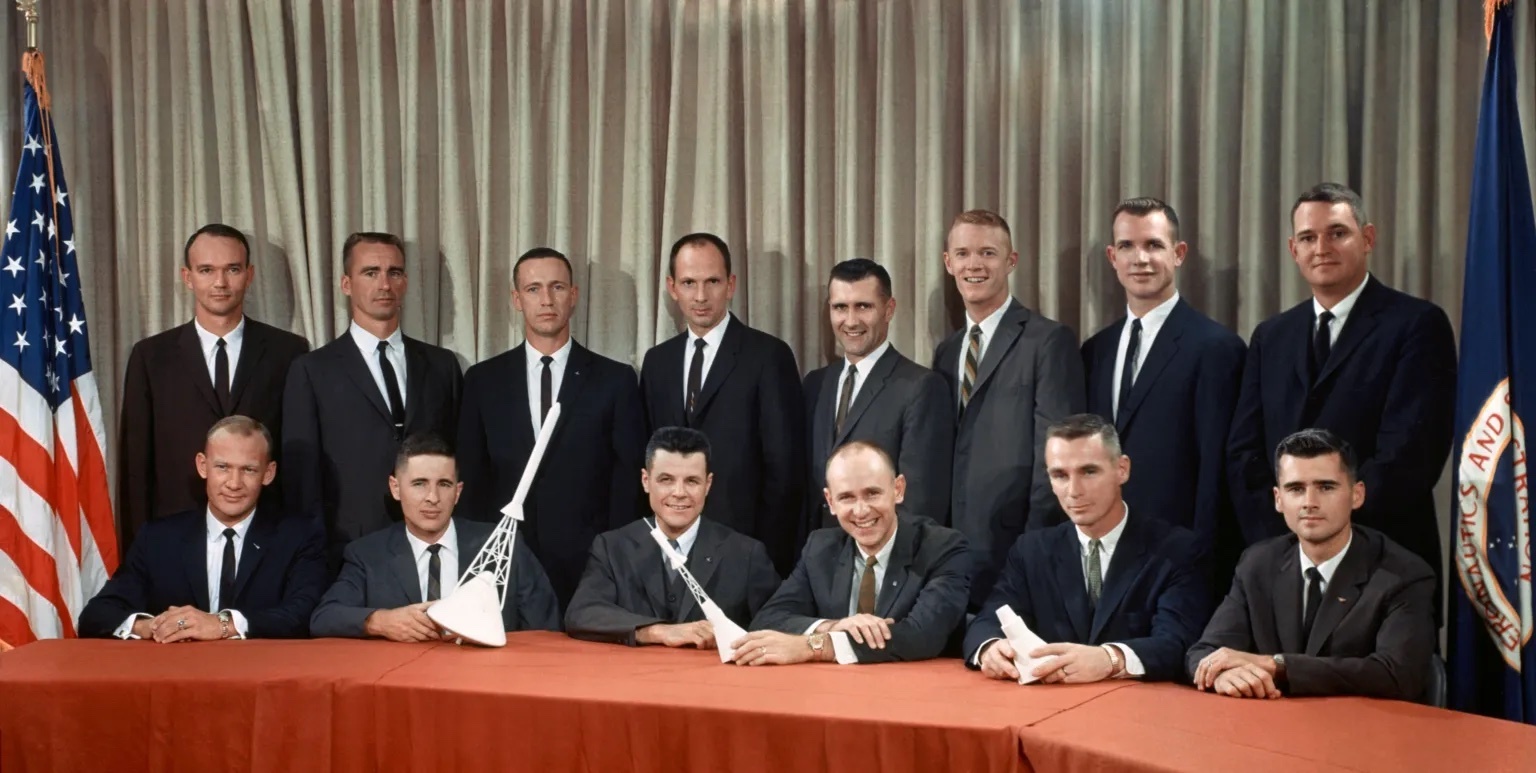
The Group 3 astronauts pose following their introduction during the Oct. 18, 1963, press conference – front row, Edwin E. “Buzz” Aldrin, left, William A. Anders, Charles M. Bassett, Alan L. Bean, Eugene A. Cernan, and Roger B. Chaffee; back row, Michael Collins, left, R. Walter Cunningham, Donn F. Eisele, Theodore C. Freeman, Richard F. Gordon, Russell L. Schweickart, David R. Scott, and Clifton C. Williams.
On Oct. 18, 1963, NASA announced the selection of its third group of astronauts. Chosen from 720 military and civilian applicants, the newest group of 14 astronauts comprised the best educated class up to that time. Seven represented the U.S. Air Force, four the U.S. Navy, one the U.S. Marine Corps, and two were civilians. NASA selected them to fly the two-seat Gemini spacecraft designed to test techniques for the Apollo Moon landing program as well as the Apollo missions themselves. Tragically, four of their members died before making their first spaceflight. The 10 surviving members of the group flew 18 important missions in the Gemini and Apollo programs, with seven traveling to the Moon and four walking on its surface. In addition, one flew a long-duration mission aboard Skylab.
On June 5, 1963, NASA announced that it would select 10-15 new candidates to augment the existing cadre of 15 active duty astronauts from its first two selections in 1959 and 1962. The agency had enough astronauts to staff the Gemini missions, but with Apollo missions then expected to begin in 1965, with up to four flights per year, it needed more astronauts. Selection criteria at the time for the candidates included U.S. citizenship, a degree in engineering or physical science, test pilot experience or 1,000 hours flying jets, 34 years old or younger, and no taller than six feet. From the 720 applications received by the July deadline, the selection board chose 136 candidates for further screening and narrowed that field down to 34 for extensive medical evaluations at Brooks Air Force Base (AFB) in San Antonio between July 31 and Aug. 15. The chair of the selection board, coordinator of astronaut activities Donald K. “Deke” Slayton, presented the names of the top 14 applicants to Robert R. Gilruth, director of the Manned Spacecraft Center (MSC), now NASA’s Johnson Space Center in Houston, who approved the list. Slayton then called each of the winning candidates with the good news. On Oct. 18, he introduced the new astronauts during a press conference in Houston. On average, this third group of astronauts were younger, slightly taller and heavier than the previous two groups, and better educated, six with master’s degrees and one having earned a doctorate.
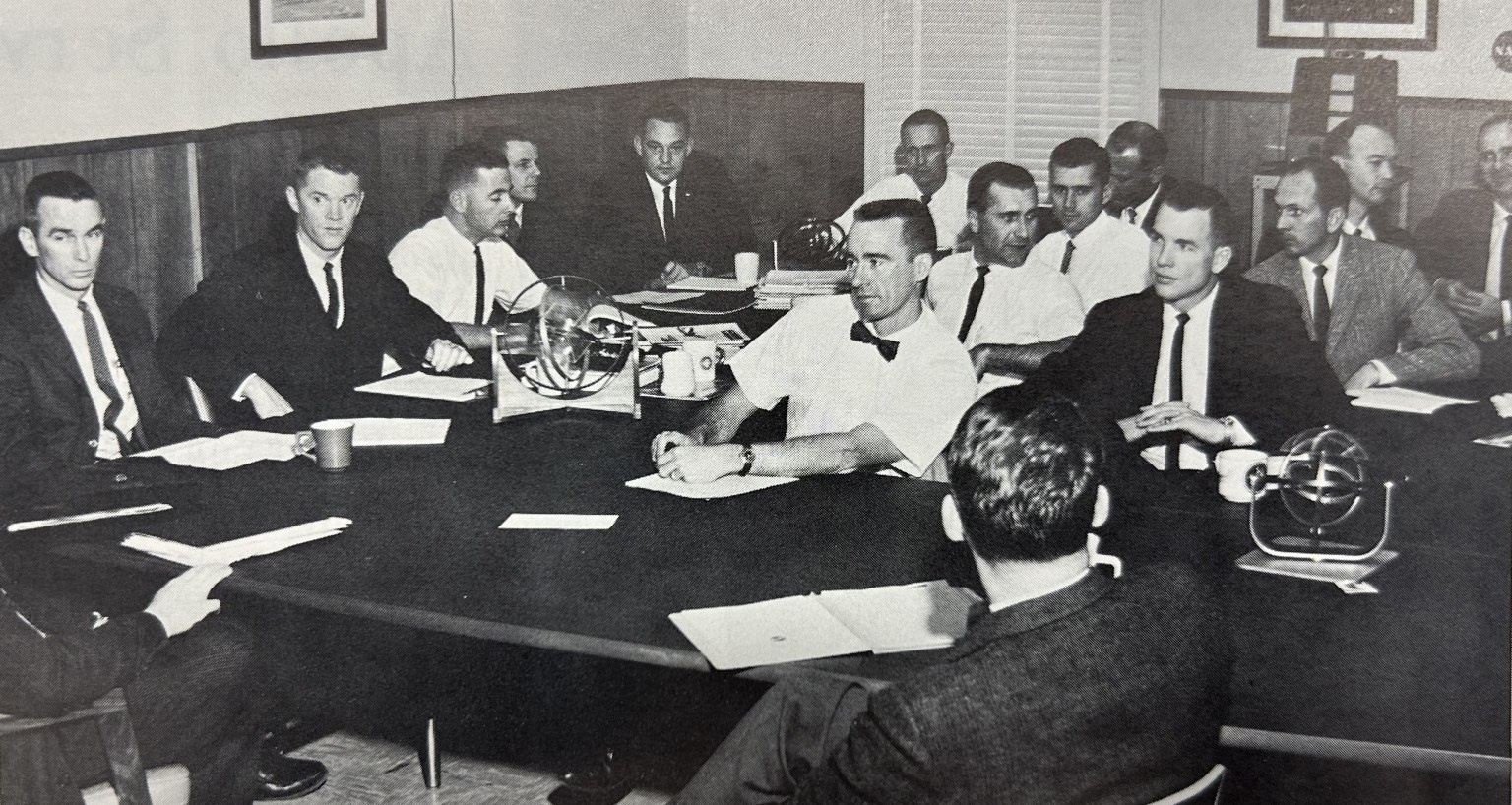
Mercury 7 astronaut and chief of operations and training for the astronaut office Walter M. Schirra, with back to camera, briefs the newly arrived 14 astronauts at the Manned Spacecraft Center, now NASA’s Johnson Space Center in Houston.
The Fourteen reported to work on Feb. 3, 1964, stationed initially at Houston’s Ellington AFB while construction of the MSC main campus on Clear Lake continued. During their first few months as astronauts, they visited various NASA centers and contractor facilities to become familiar with the space program’s major elements. Each astronaut received a technical assignment to gain expertise in specific aspects of spaceflight to pass their knowledge on to the rest of the group, and to help in the design of spacecraft, rockets, spacesuits, control systems, and simulators. Additionally, their 240-hour course work covered topics such as astronomy, aerodynamics, rockets, communications, space medicine, meteorology, upper atmospheric physics, navigation, orbital mechanics, computers, and geology. Because some of the group members could potentially receive assignments to land on the Moon, training including field trips to geologically interesting sites where they received instruction from geologists. They conducted jungle survival training in Panama, desert survival training around Reno, Nevada, and water survival training at the Pensacola, Florida, Naval Air Station.
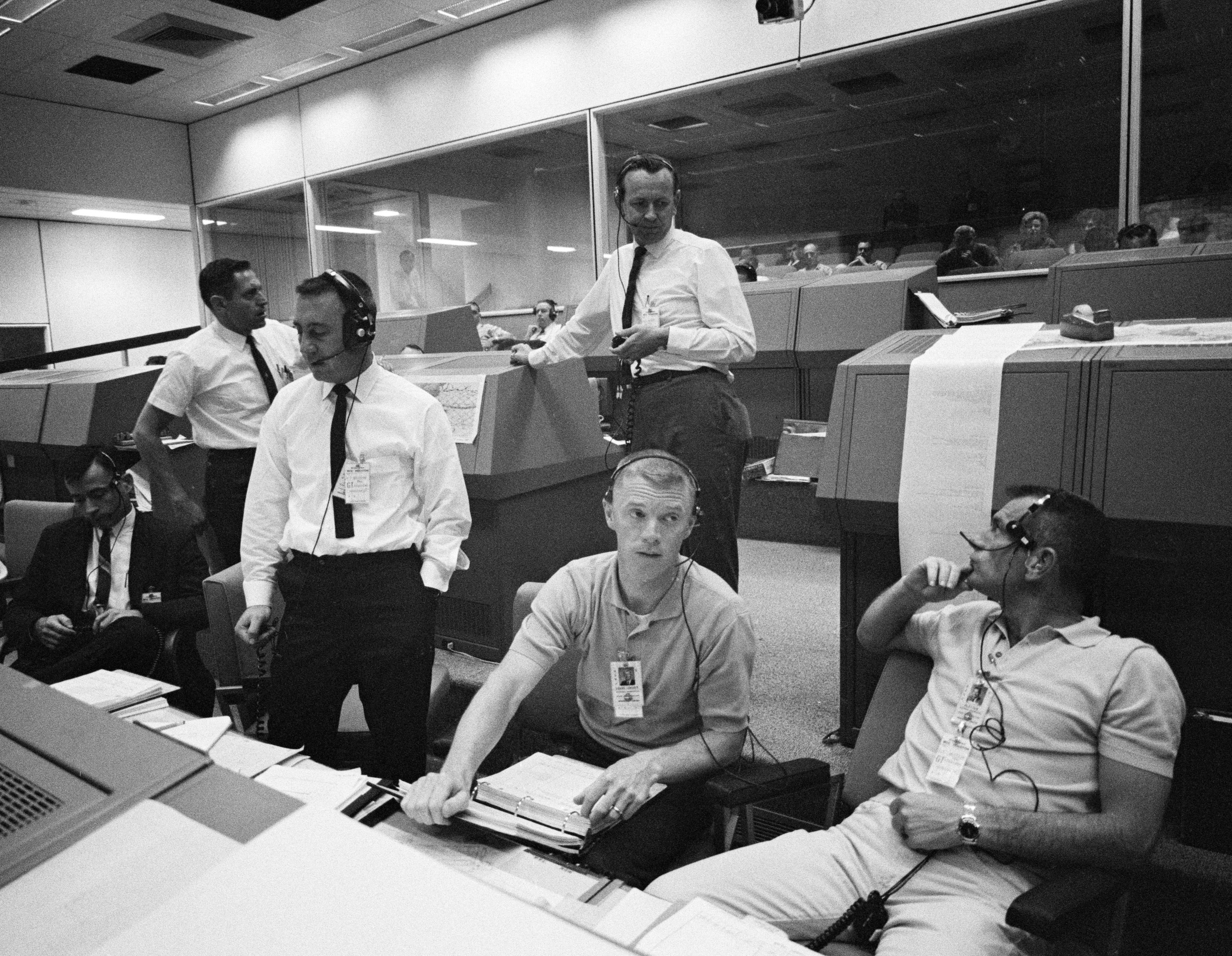
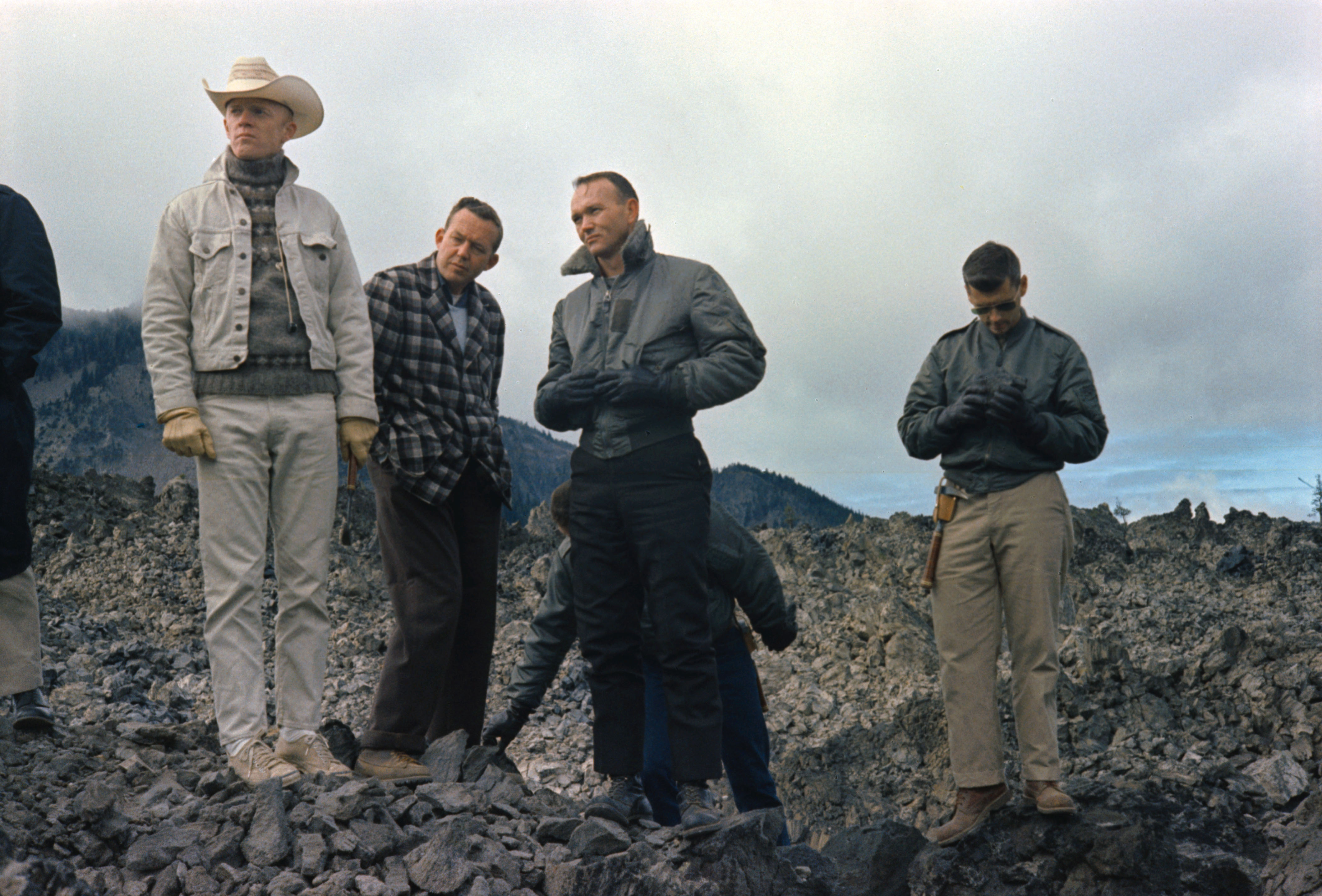
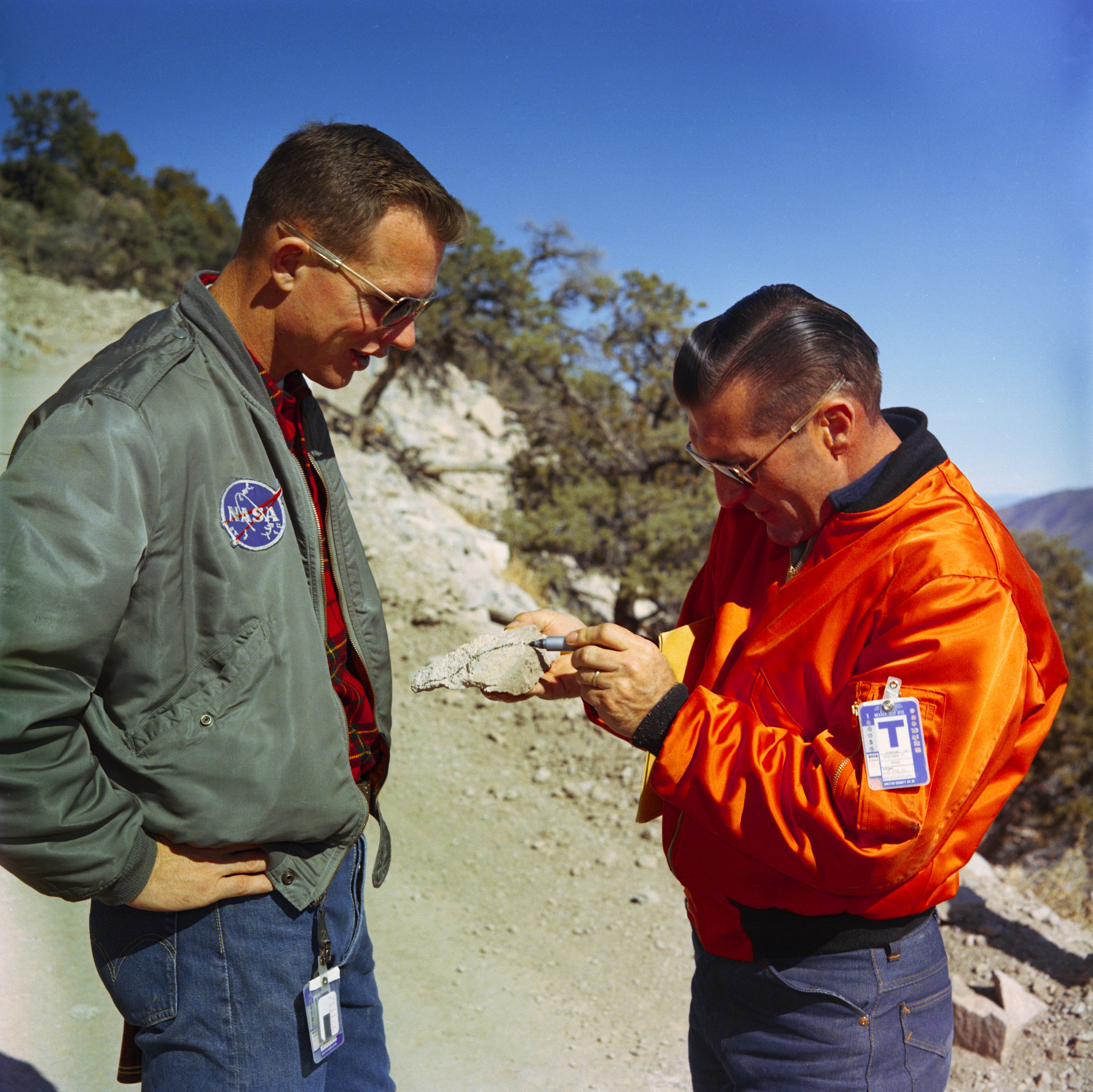
Left: Group 3 astronaut Russell L. “Rusty” Schweickart, center, gets hands on experience as capsule communicator (capcom) during Gemini IV, the first flight controlled from the Mission Control Center at the Manned Spacecraft Center, now NASA’s Johnson Space Center in Houston. Middle: Schweickart, geologist Uel Clanton, Michael Collins, and Roger B. Chaffee during geology training near Bend, Oregon. Right: David R. Scott, left, and Richard F. Gordon examine a rock sample during a geology field trip to the Nevada Test Site at Yucca Flats.
Of the 14, seven came from the U.S. Air Force (USAF), four from the U.S. Navy (USN), one from the U.S. Marine Corps (USMC), and two were civilians at the time of selection but had military experience. The astronauts included Edwin E. “Buzz” Aldrin (USAF), William A. Anders (USAF), Charles M. Bassett (USAF), Alan L. Bean (USN), Eugene A. Cernan (USN), Roger B. Chaffee(USN), Michael Collins (USAF), R. Walter Cunningham (civilian), Donn F. Eisele (USAF), Theodore C. “Ted” Freeman (USAF), Richard F. Gordon (USN), Russell L. “Rusty” Schweickart (civilian), David R. Scott (USAF), and Clifton C. “CC” Williams (USMC). Williams had the distinction as the first bachelor astronaut, a distinction he lost in July 1964.
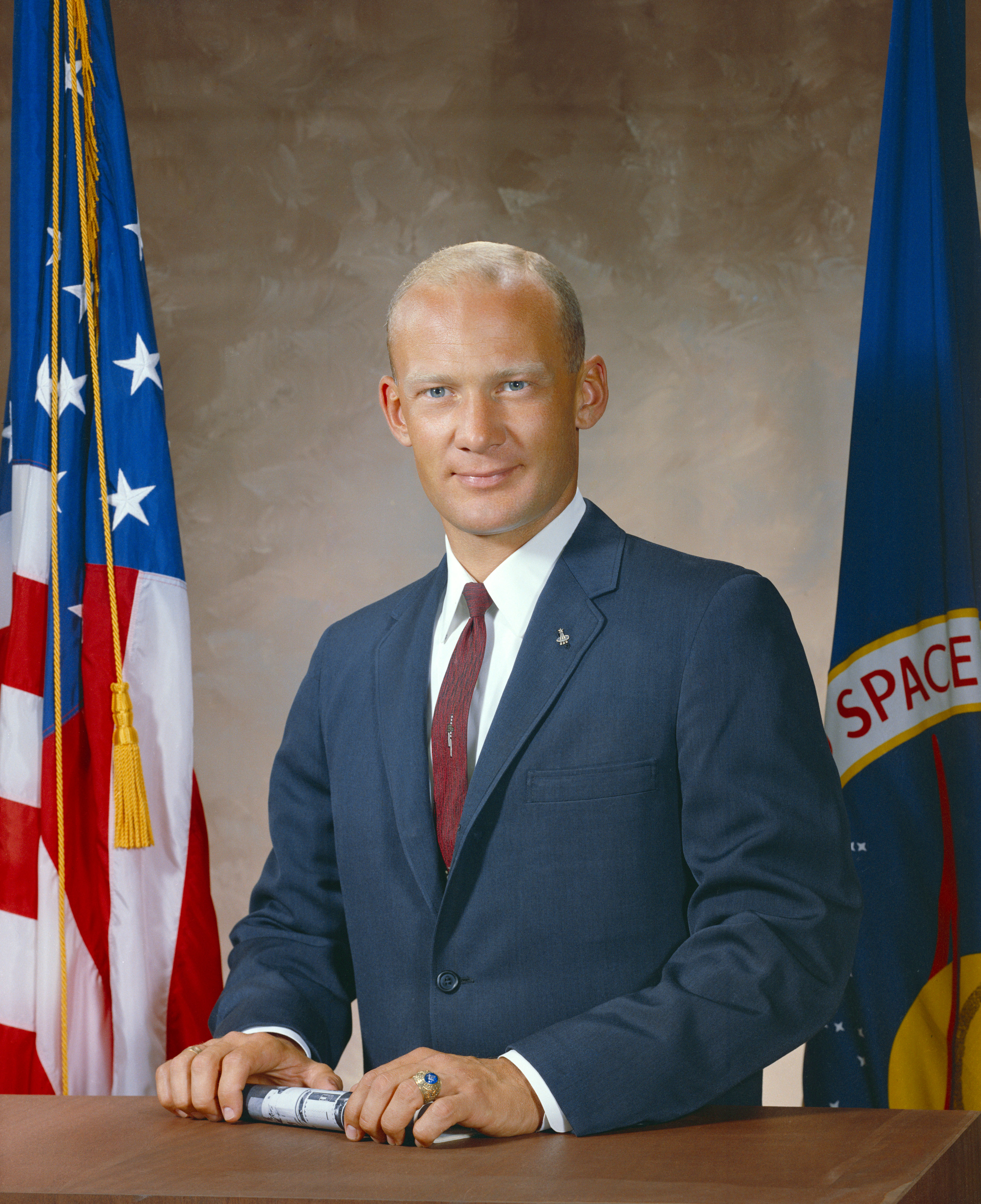
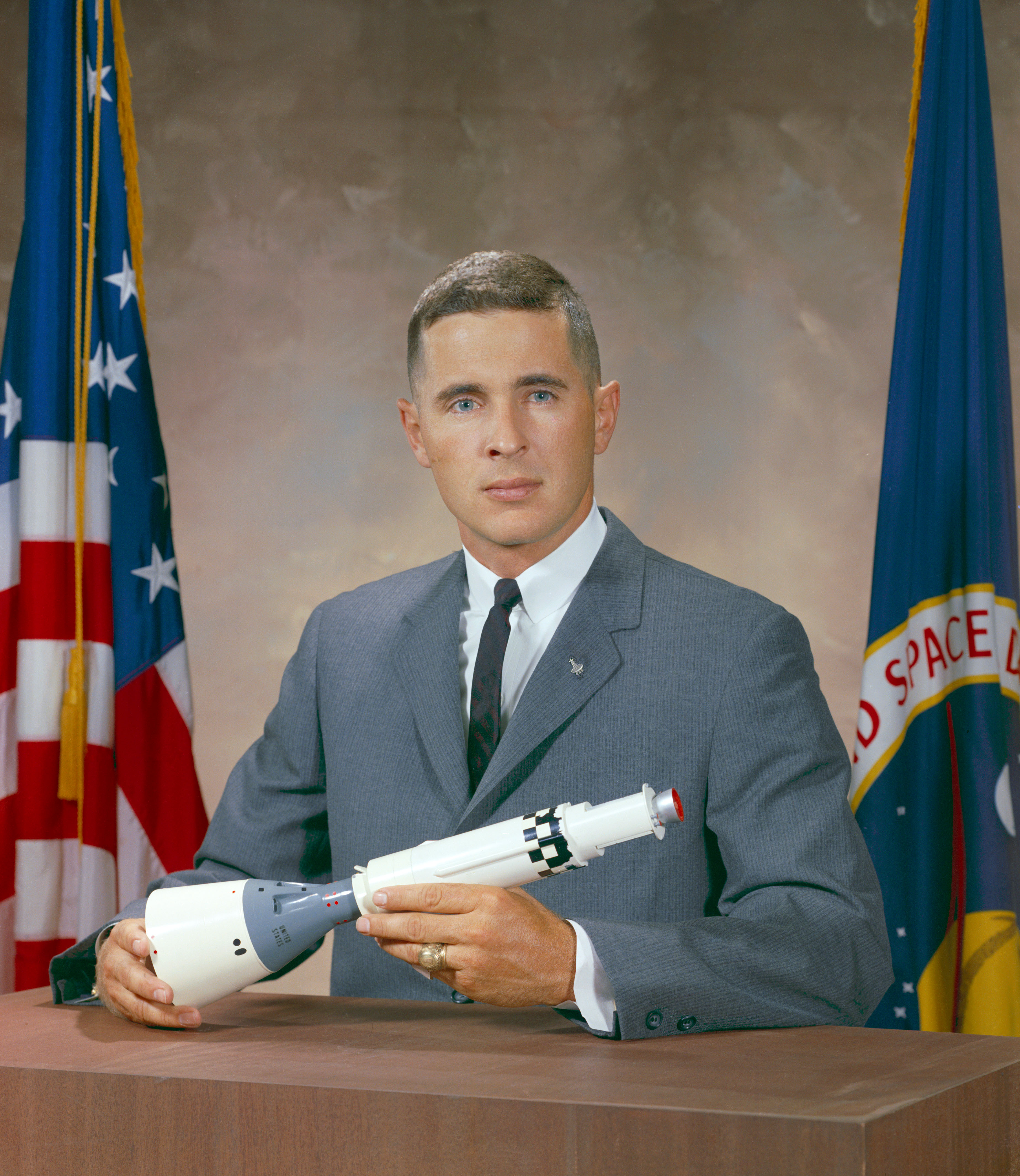
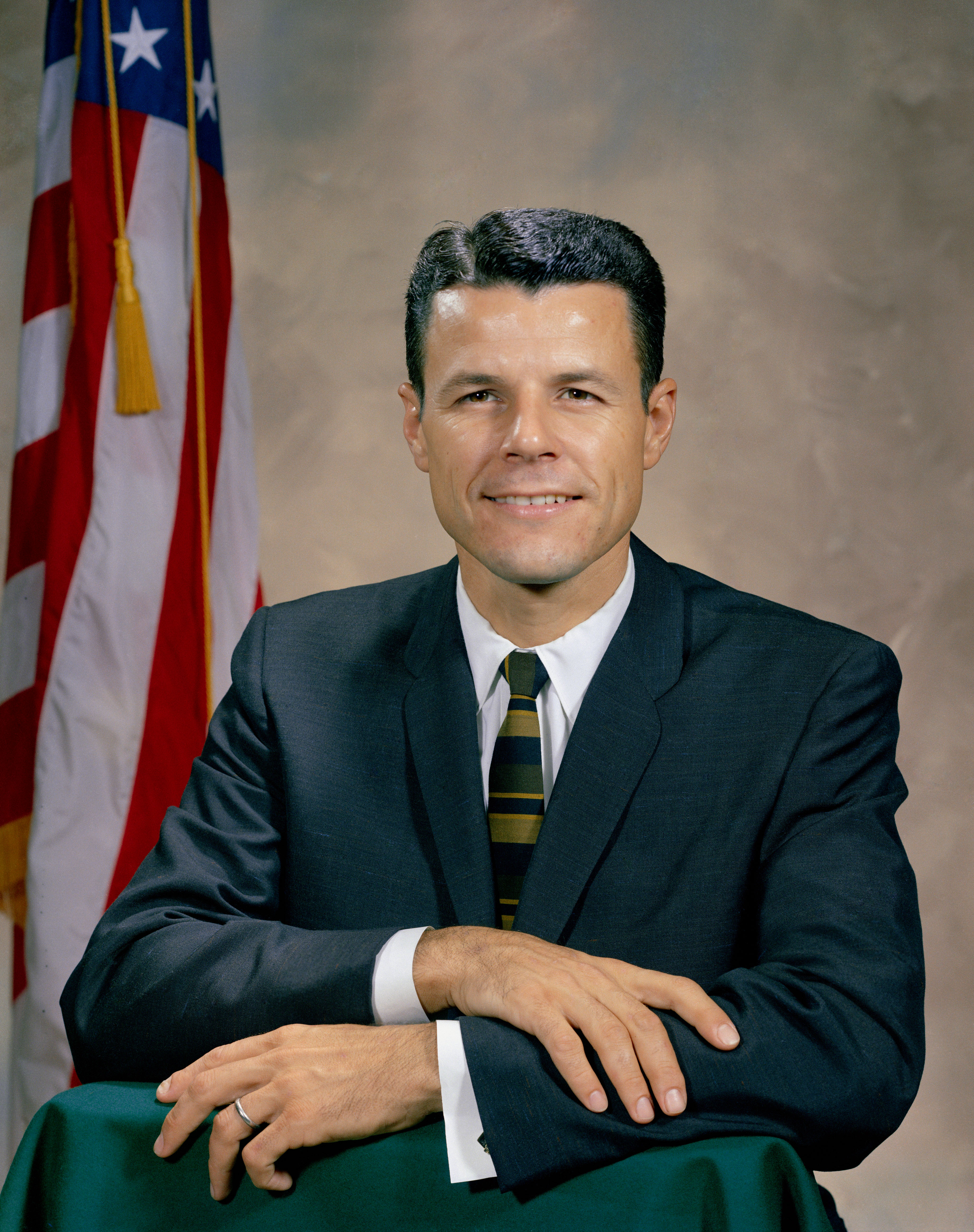
Group 3 astronauts Edwin E. “Buzz” Aldrin, left, William A. Anders, and Charles M. Bassett.
Aldrin, who wrote his thesis on orbital rendezvous techniques for his Ph.D. in astronautics from the Massachusetts Institute of Technology in Cambridge, earned the nickname Dr. Rendezvous. Appropriately, Slayton tasked him to help with mission planning. Aldrin received his first crew assignment as the backup pilot for Gemini IX that included training for a spacewalk. He put that experience, plus additional training in a neutral buoyancy simulator, or underwater training to better simulate weightlessness, during his four-day Gemini XII flight during which he successfully completed three spacewalks. Moving on to the Apollo program, Aldrin next served as the backup Command Module Pilot (CMP) for the Apollo 8 first lunar orbital mission. As the prime Lunar Module Pilot (LMP) on Apollo 11, Aldrin became the second man to walk on the Moon in July 1969. He retired from NASA the following year.
Slayton assigned Anders, who held a master’s degree in nuclear engineering, to follow the development of environmental controls for Gemini and Apollo spacecraft. His first mission assignment came as the backup pilot for Gemini XI, and then as prime LMP on Apollo 8. He is credited with taking the famous Earthrise photo while he and his crewmates orbited the Moon. He served as backup CMP on Apollo 11, before retiring from NASA in August 1969 to join the National Aeronautics and Space Council.
Bassett’s technical assignment included training and simulators. Slayton assigned him as pilot on Gemini IX, a mission that included docking and a spacewalk. Tragically, on Feb. 28, 1966, just three months before their planned mission, Bassett and his command pilot Elliott M. See died in the crash of their T-38 Talon aircraft as they approached Lambert International Airport in St. Louis in inclement weather.
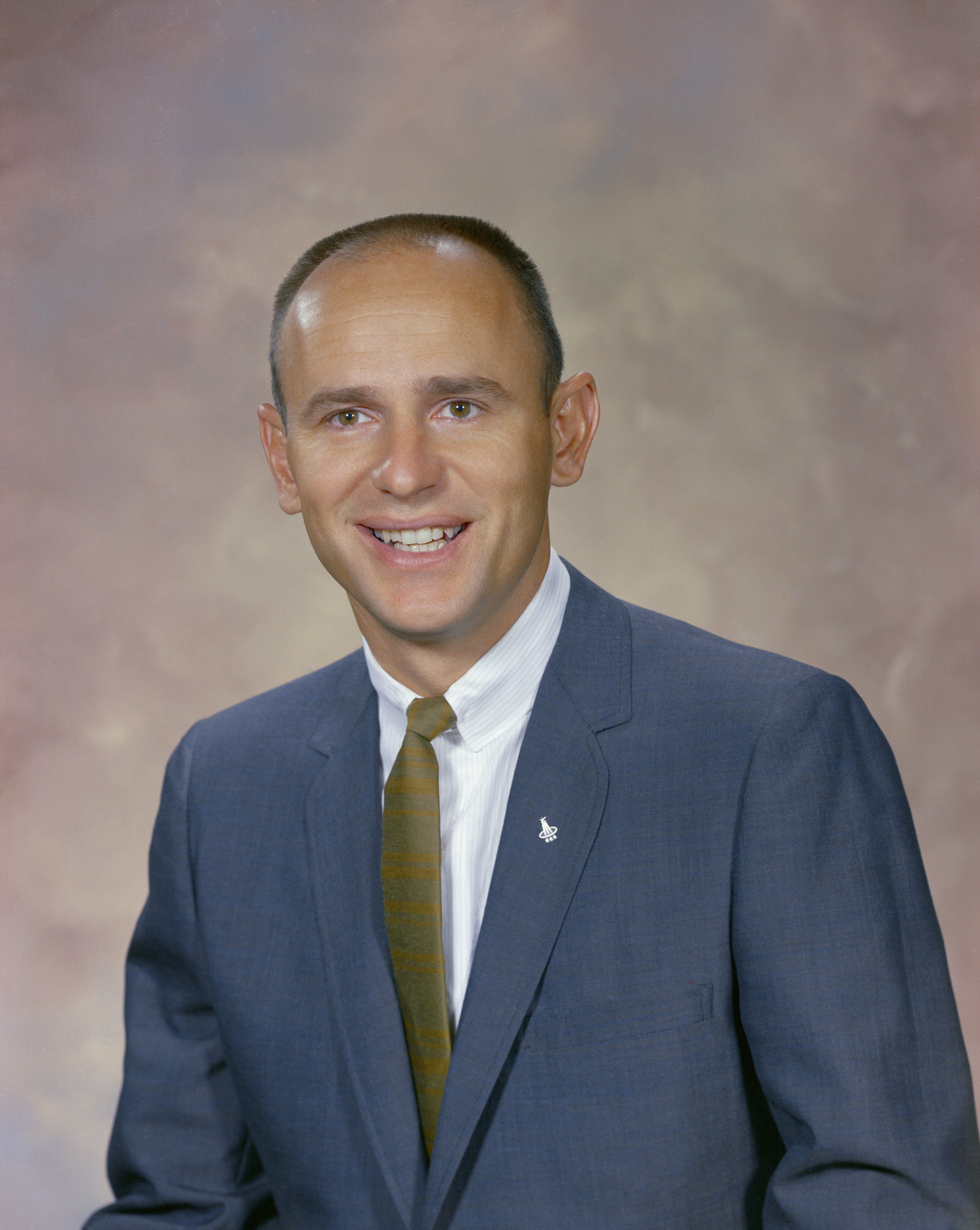
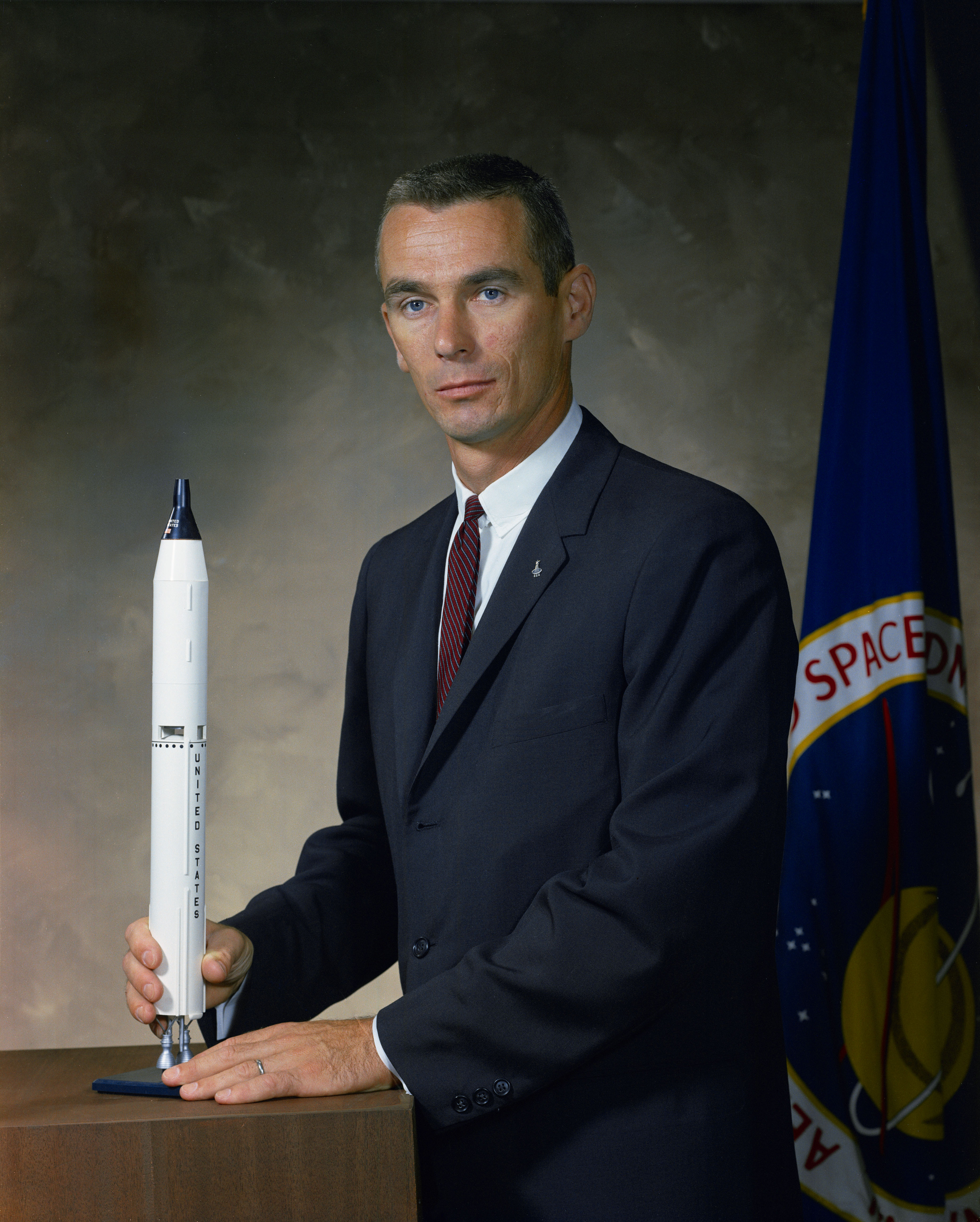
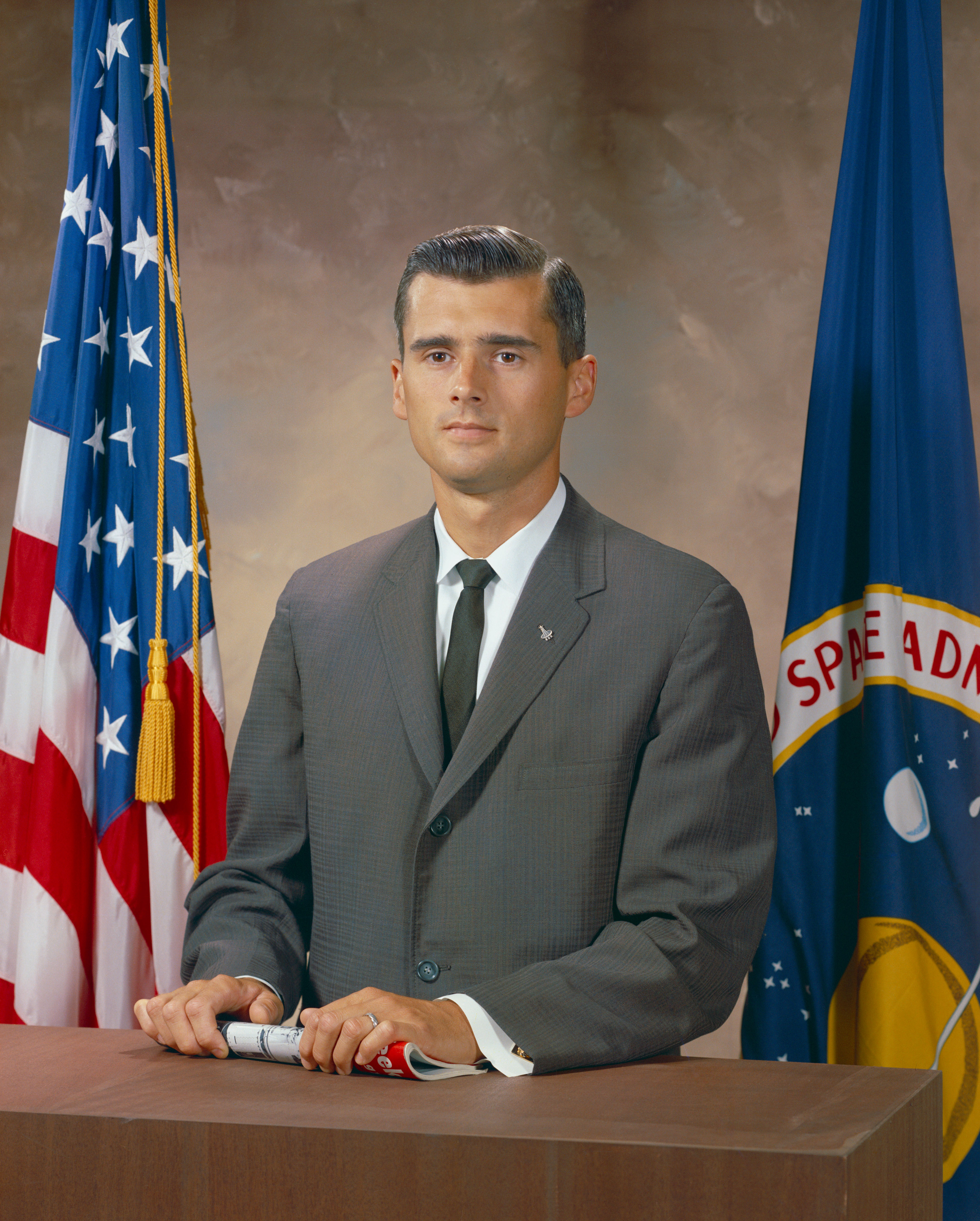
Group 3 astronauts Alan L. Bean, left, Eugene A. Cernan, and Roger B. Chaffee.
Bean’s primary technical assignment involved spacecraft recovery systems. Slayton first assigned him as backup command pilot on Gemini X with Williams as his pilot. He next served as the backup LMP on Apollo 9, the first mission to test the Lunar Module (LM) in Earth orbit. That put him in position as the prime LMP on Apollo 12. During that mission he became the fourth man to walk on the Moon. He later served as the commander for the 59-day Skylab 3 mission in 1973 and as the backup commander for the Apollo-Soyuz Test Project (ASTP) in 1975. He retired from NASA in 1981.
Cernan, with a master’s in aeronautical engineering, followed the development of spacecraft propulsion and the Agena docking target for Gemini missions. Slayton assigned him as backup pilot for Gemini IX, and following the deaths of See and Bassett, Cernan and his commander Thomas P. Stafford took over as the prime crew. As luck would have it, they did not have a chance to dock with an Agena as it did not make it to orbit. Cernan conducted the second American spacewalk during that mission. He served as Aldrin’s backup on Gemini XII and then as the backup LMP on Apollo 7. That rotated him to the prime crew on Apollo 10, the dress rehearsal for the Moon landing during which he and Stafford took their LM to within nine miles of the lunar surface. He served as backup commander for Apollo 14, and then as prime commander of Apollo 17, the final Apollo Moon landing mission, he left the last footprints of that program in the lunar soil in December 1972. He remains one of only three people to have traveled to the Moon twice. He retired from NASA in 1976.
Chaffee’s technical assignment led him to follow the development of spacecraft communications systems. In March 1966, Slayton assigned him to the first crewed Apollo mission, along with commander Virgil I. “Gus” Grissom and senior pilot Edward H. White. Tragically, the three died on Jan. 27, 1967, in a fire aboard their spacecraft during a ground test on the launch pad.
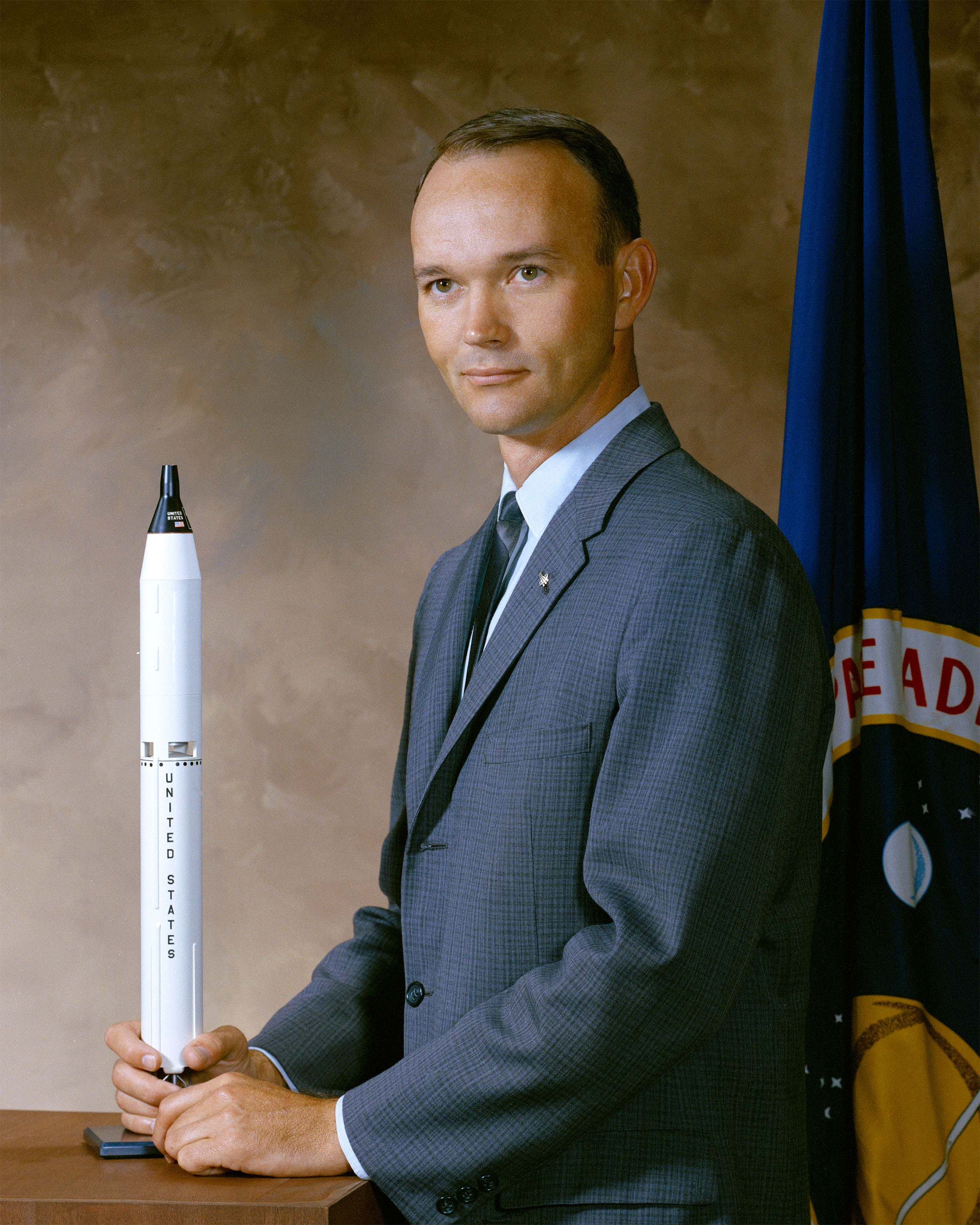
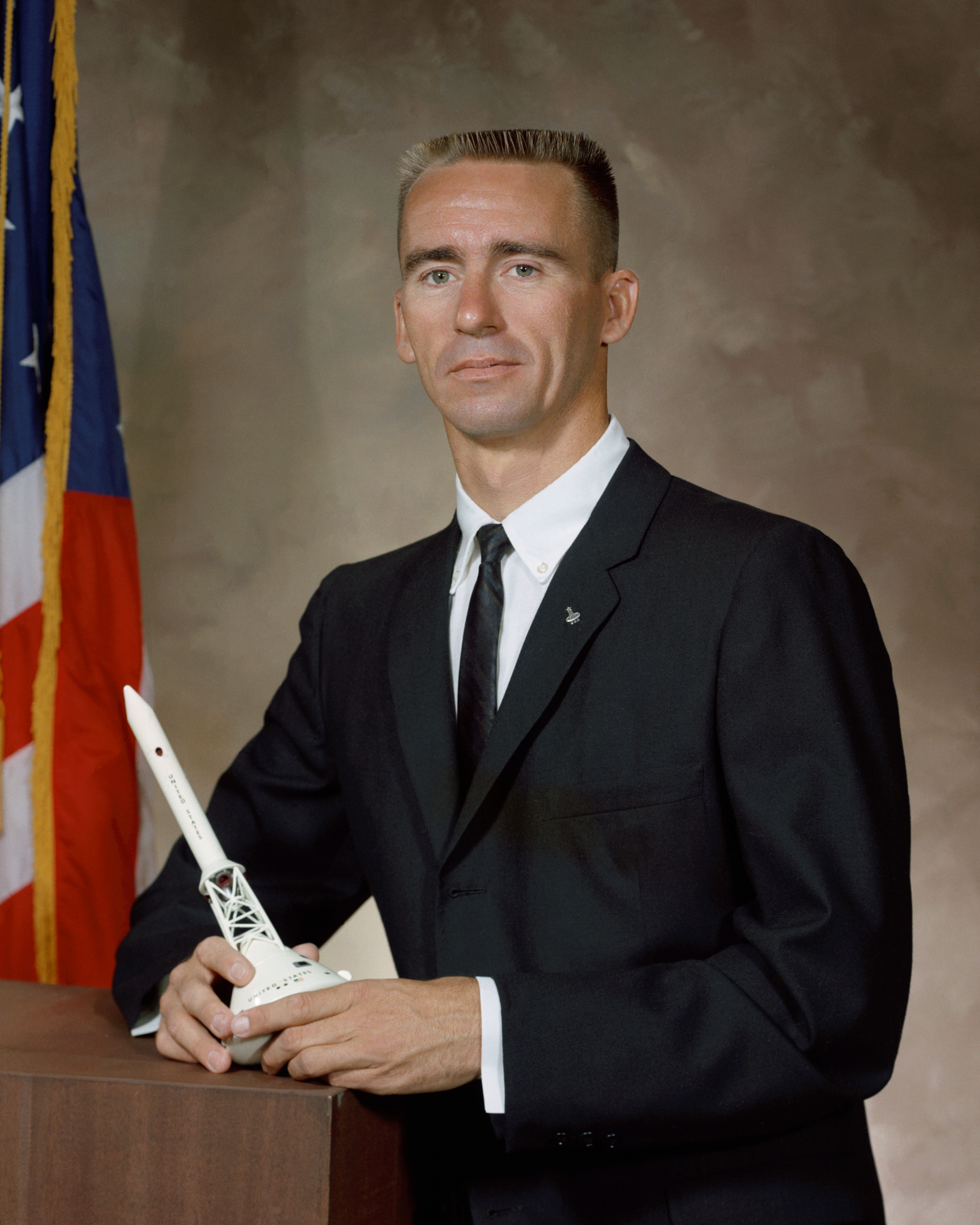
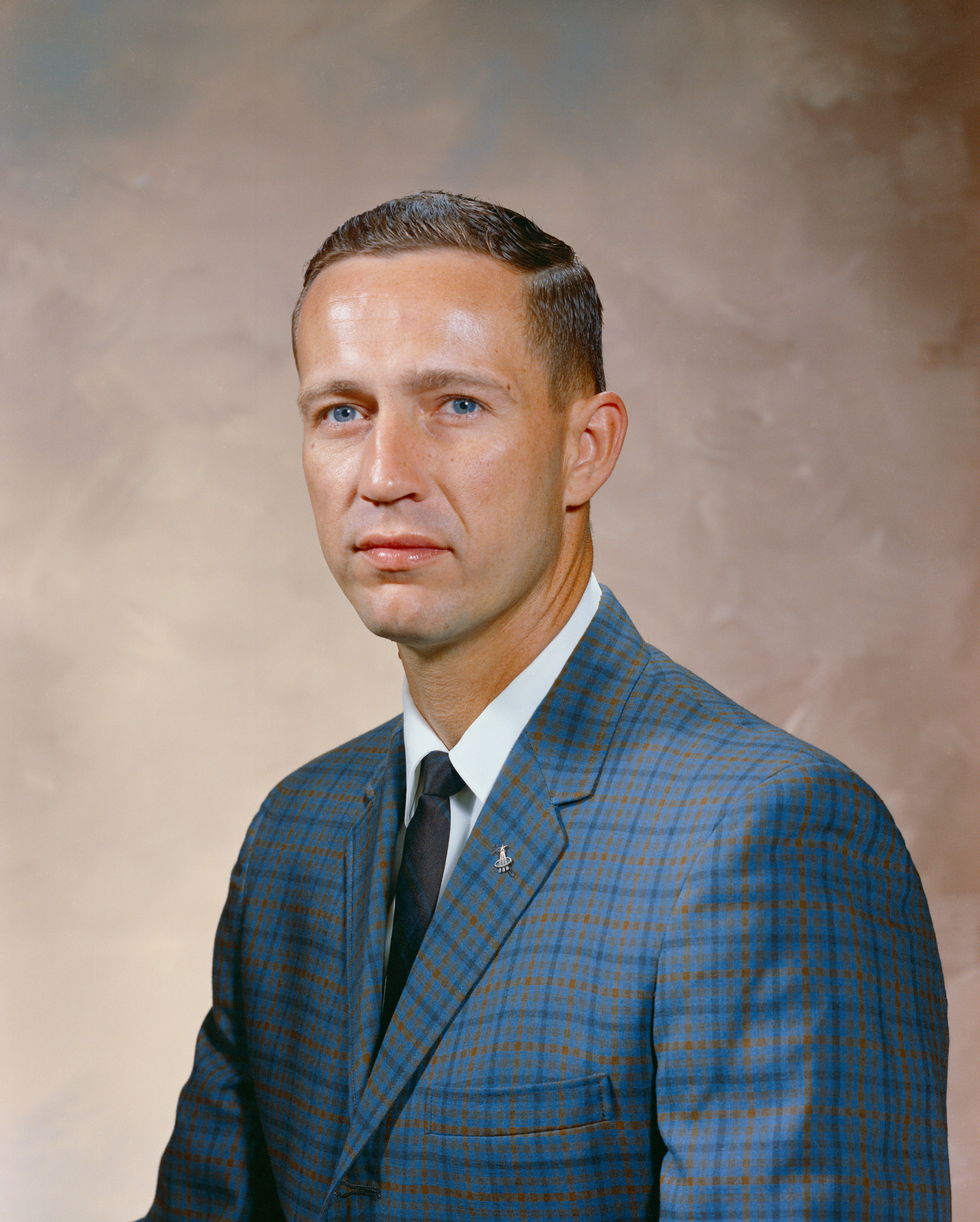
Group 3 astronauts Michael Collins, left, R. Walter Cunningham, and Donn F. Eisele.
Collins, who had applied for the 1962 class but did not get selected, followed the development of pressure suits and spacewalking systems. As his first crew assignment, he served as the backup pilot for the long duration Gemini VII mission. He next served as the pilot for Gemini X, the first mission to complete a rendezvous with two Agena targets, and during which he conducted two spacewalks. He briefly served as the CMP on the Apollo 8 crew before being sidelined by surgery to correct a bone spur in his neck. After his recovery, he served as the CMP on Apollo 11, the first Moon landing mission. He retired from NASA in 1970, and went on to serve as the director of the Smithsonian Institution’s National Air and Space Museum in Washington, D.C., overseeing the building of its new facility that opened for the nation’s bicentennial in 1976.
Cunningham, who held a master’s degree in physics and had nearly completed work on his Ph.D. when selected, oversaw the development of ground-based experiments to support spaceflights. Slayton assigned him to the second crewed Apollo mission, along with classmate Eisele and Walter M. Schirra as their commander. Later, Slayton reassigned them to back up the first Apollo crew of Grissom, White, and Chaffee. After the Apollo fire, Schirra, Eisele, and Cunningham became the prime crew for Apollo 7, the first crewed Apollo flight. After working on the Skylab program, he retired from NASA in 1971.
Slayton assigned Eisele, who held a master’s degree in astronautics, to oversee the development of spacecraft attitude control systems. Slayton assigned Eisele, along with Schirra and Cunningham to the second crewed Apollo mission, then reassigned them to back up the first Apollo crew. After the fire, Schirra, Eisele, and Cunningham became the prime crew for the first Apollo mission, completing the 11-day Apollo 7 mission in October 1968. Eisele later served as the backup CMP for Apollo 10. He retired from NASA in 1972.
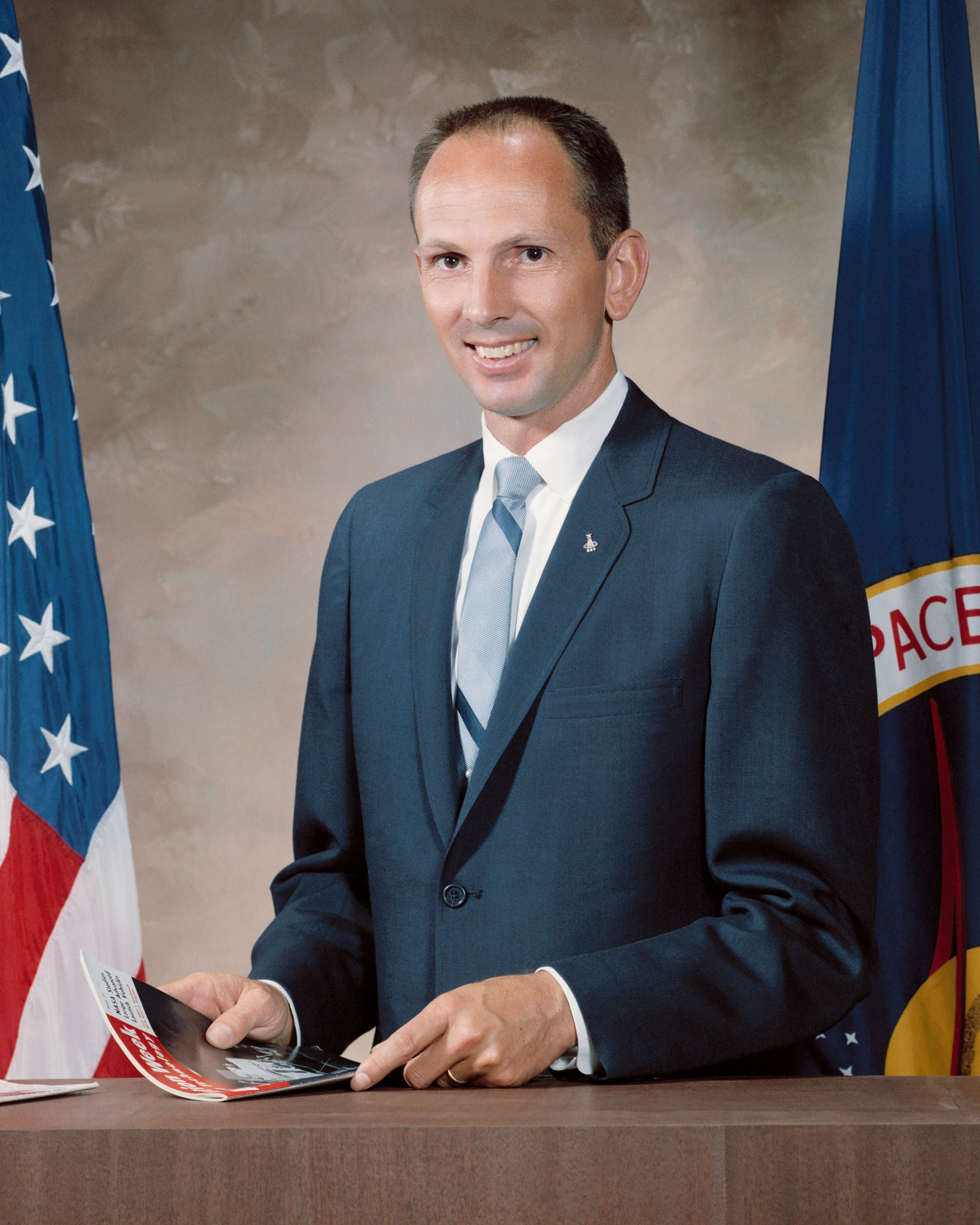
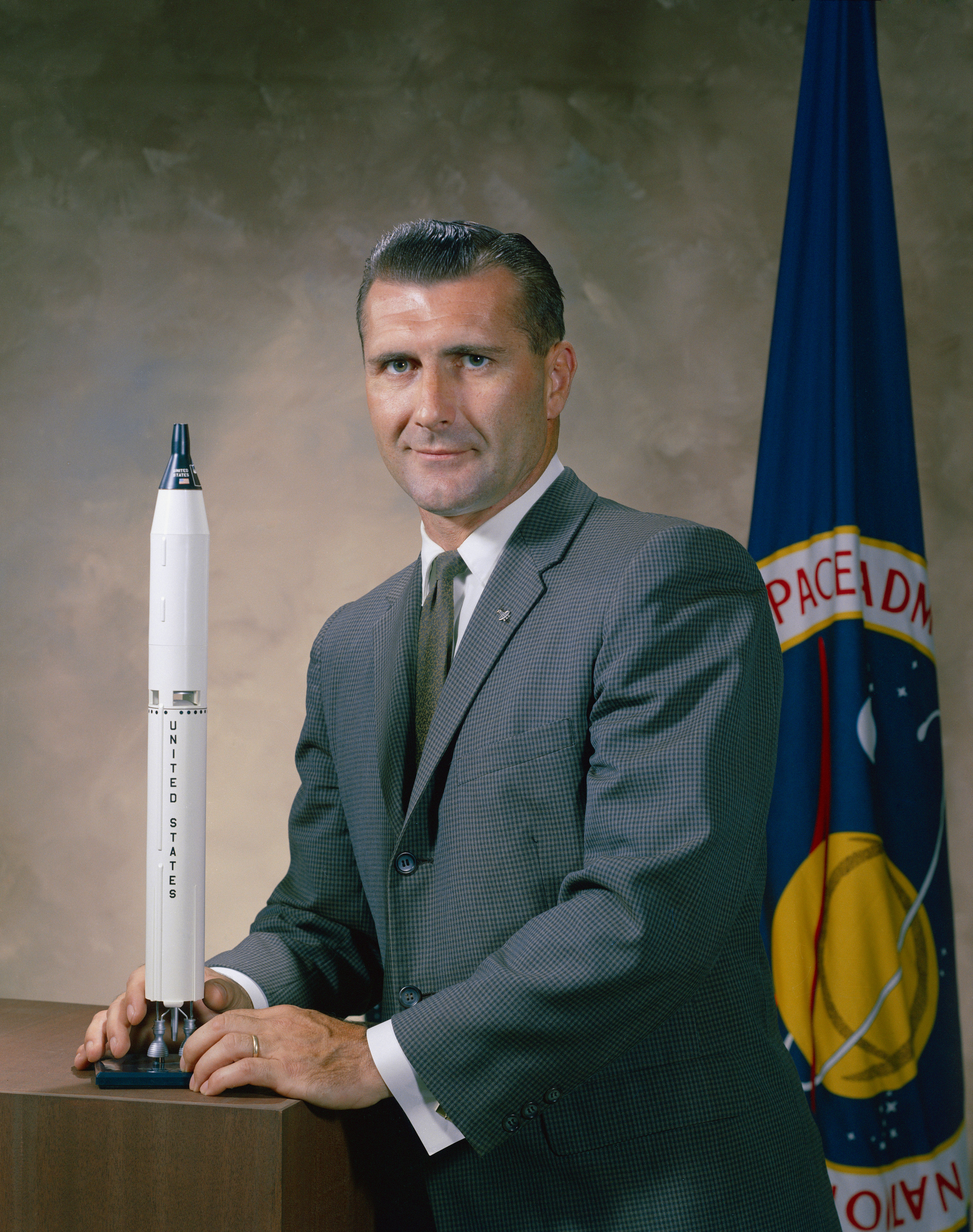
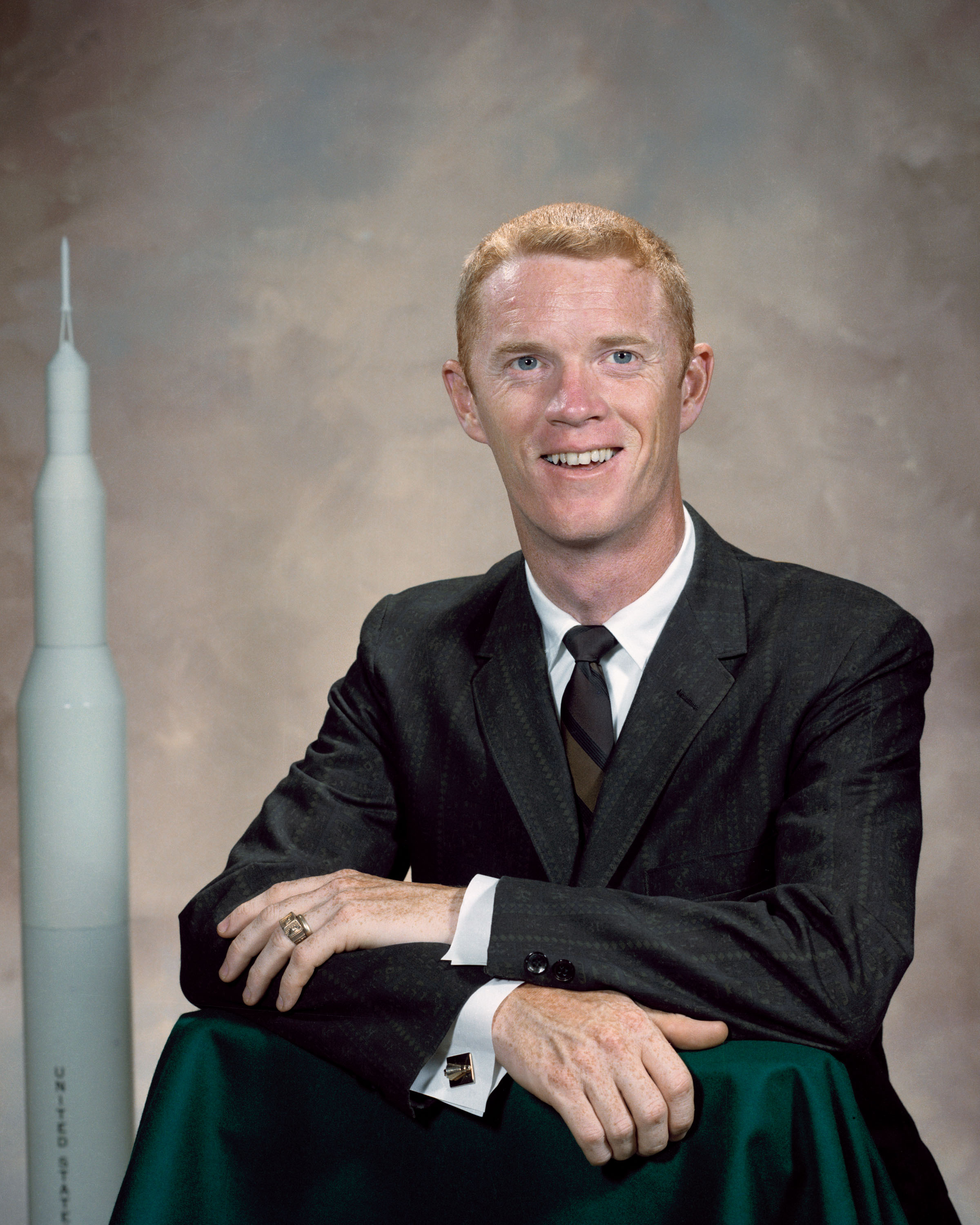
Group 3 astronauts Theodore C. Freeman, left, Richard F. Gordon, and Russell L. “Rusty” Schweickart.
With a master’s degree in aeronautical engineering, Freeman’s technical assignment involved following the development of the various boosters for the Gemini and Apollo programs. Tragically, before he received a flight assignment, Freeman died in the crash of a T-38 Talon aircraft on Oct. 31, 1964, near Ellington AFB in Houston. He was the first active duty astronaut to perish.
Slayton put Gordon in charge of following the design of cockpit controls. Gordon’s first crew assignment was as backup pilot for Gemini VIII, the first docking mission. He next served as the pilot for Gemini XI that completed the docking with their Agena target on the first revolution. He conducted two spacewalks during that mission. On his next assignment, he served as the backup CMP for Apollo 9, and then as prime CMP on Apollo 12, the second Moon landing mission. His last official assignment as backup commander of Apollo 15 would have led him to most likely be commander of Apollo 18, but budget cuts in September 1970 canceled that mission. He retired from NASA the following year.
Schweickart, the youngest member of this astronaut class and with a master’s in aeronautics and astronautics, oversaw the development and integration of inflight experiments. First assigned in March 1966 as Chaffee’s backup on the first crewed Apollo mission, Schweickart and his crew mates James A. McDivitt and fellow classmate Scott were reassigned to the mission to carry out the first in-orbit test of the LM. They flew that mission as Apollo 9 in March 1969. Schweickart later served as the backup commander of the first Skylab crew. He retired from NASA in 1977.
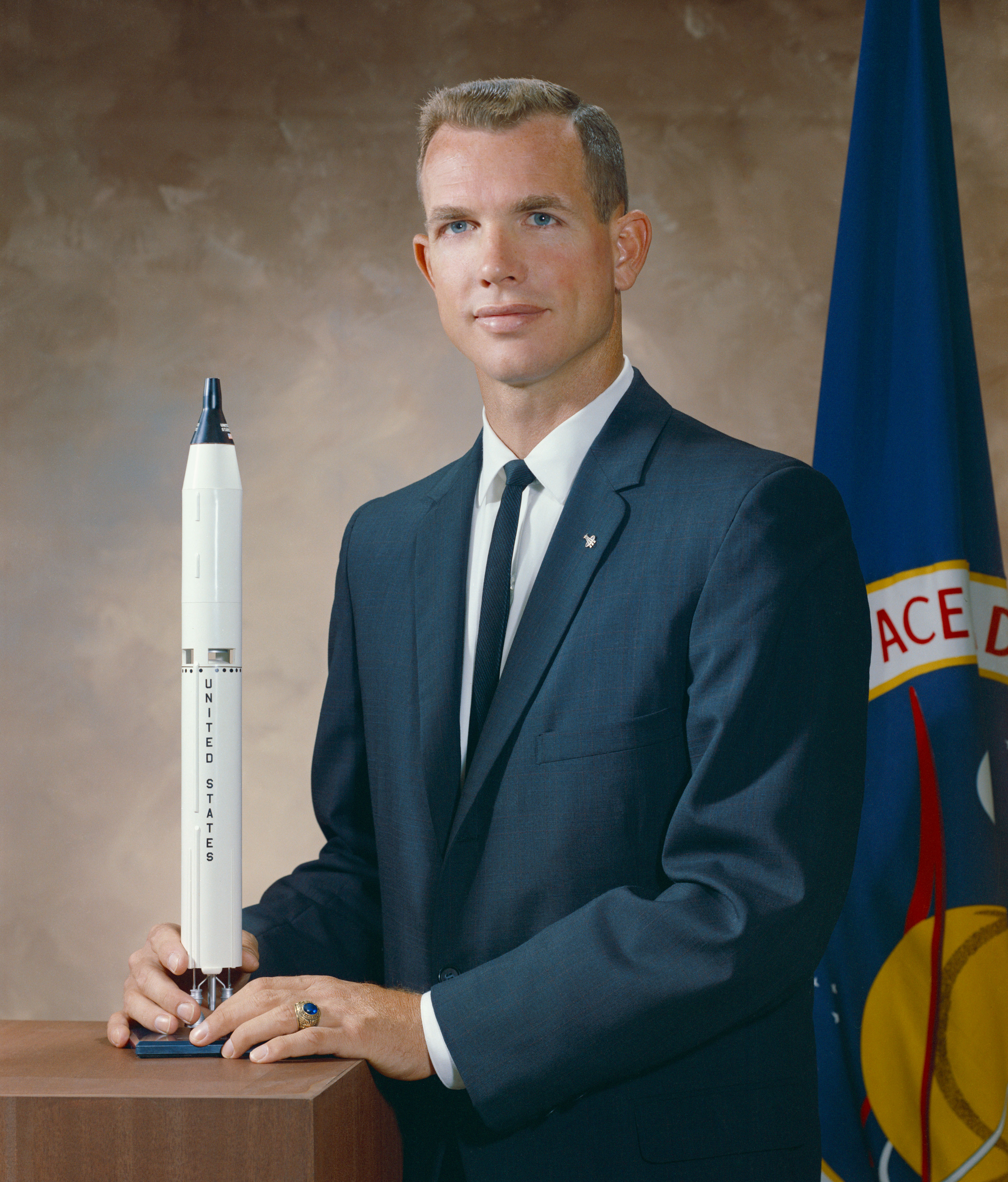
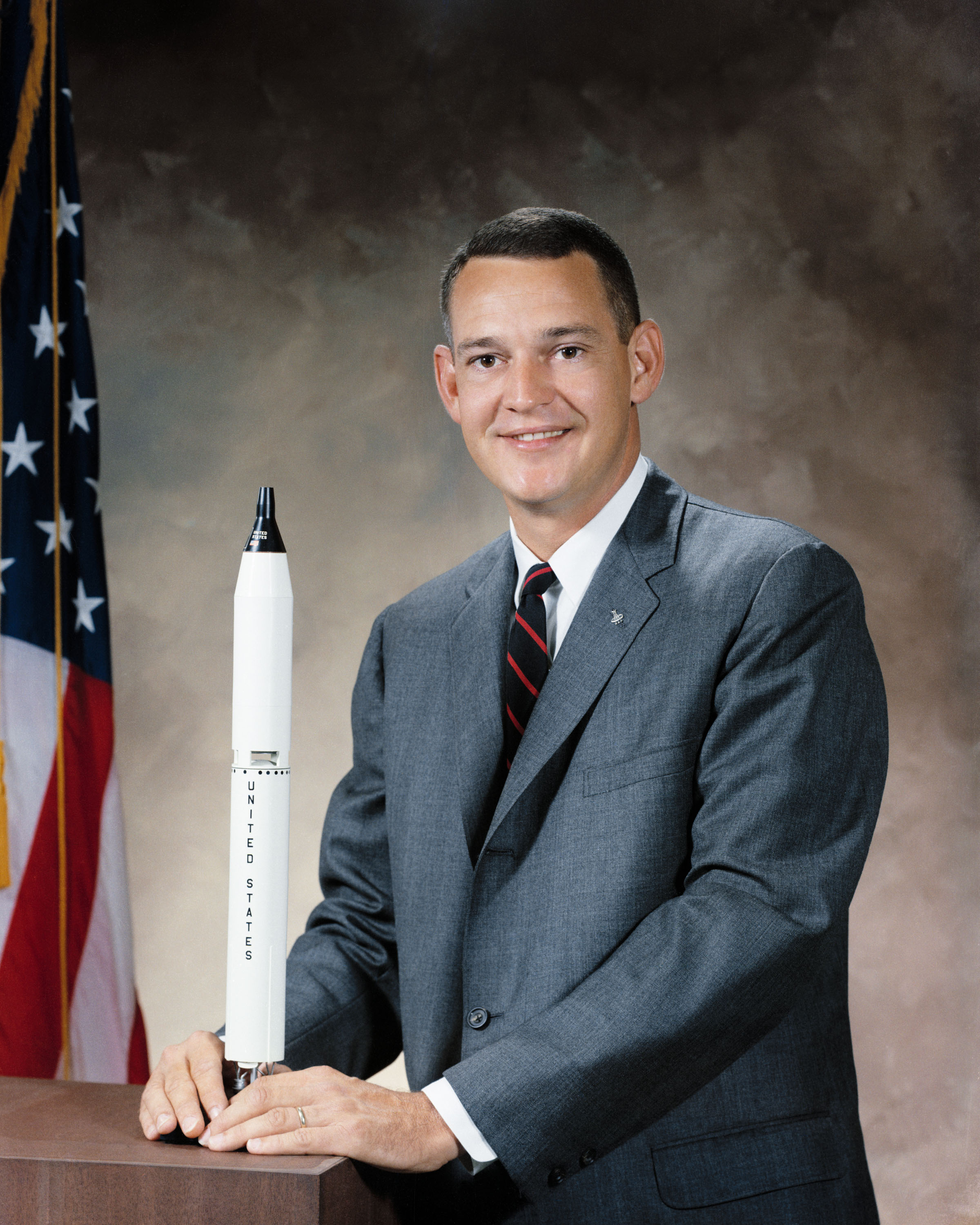
Group 3 astronauts David R. Scott, left, and Clifton C. “CC” Williams.
Slayton placed Scott, who held a master’s degree in aeronautics and astronautics, in charge of monitoring the development of guidance and navigation systems. On his first crew assignment, he served as pilot on Gemini VIII, the mission that featured the first docking with an Agena target and the first in-space emergency requiring an immediate return to Earth. Just days after that harrowing flight in March 1966, Scott was named to the backup crew for the first Apollo mission, but later he, McDivitt, and Schweickart were reassigned to the first flight to test the LM in space, the flight that flew as Apollo 9 in March 1969. Scott next served as backup commander of Apollo 12, then as prime commander of Apollo 15. He became the seventh man to walk on the Moon and the first to drive there, using the Lunar Roving Vehicle. After leaving the astronaut corps, he served first as the deputy director and then the director of NASA’s Dryden, now Armstrong, Flight Research Center at Edwards AFB in California’s Mojave Desert. He retired from NASA in 1977.
Williams, the only Marine and lone bachelor of the group (he married in July 1964), oversaw range operations and crew safety. Slayton assigned Williams as the backup pilot for Gemini X, and later he served as the LMP on a backup crew for the first flight of the LM in Earth orbit, along with Charles “Pete” Conrad and fellow classmate Gordon. Tragically, Williams died in the crash of a T-38 Talon aircraft near Tallahassee, Florida, on Oct. 5, 1967. Bean replaced him on Conrad’s crew, that became the Apollo 9 backup crew and ultimately the prime crew for Apollo 12. At Bean’s suggestion, Williams is memorialized on the Apollo 12 crew patch as a fourth star, the other three stars representing the actual flight crew.
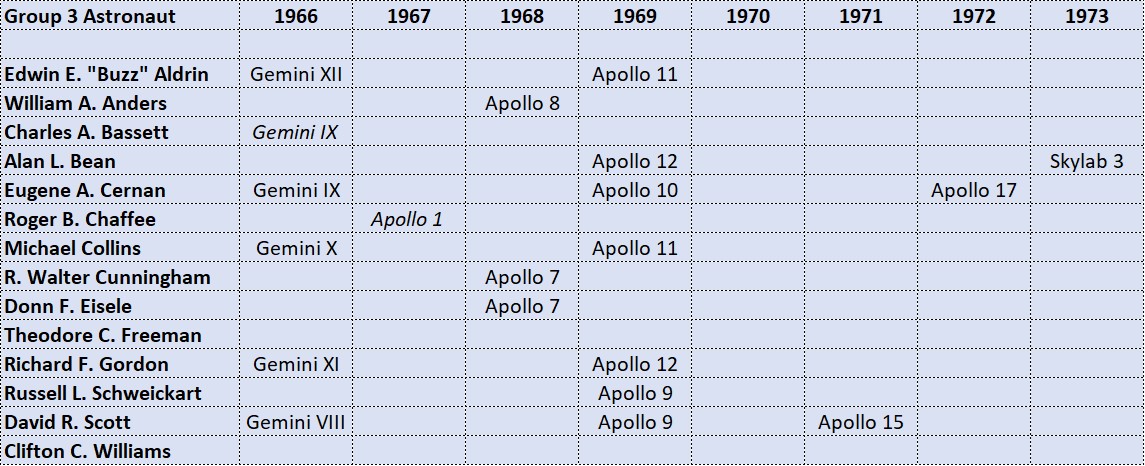
Summary of spaceflights by Group 3 astronauts. The boxes with flight names in italics represent astronauts who died before they could undertake the mission.
As a group, The Fourteen tragically had the highest mortality rate of any astronaut class. The surviving 10 astronauts completed a total of 18 flights, five Gemini missions, 12 Apollo missions, and one Skylab mission. Of the group, Collins received the first crew assignment as Gemini VII backup pilot, while Scott made the first spaceflight on Gemini VIII. Bean made the last spaceflight by a Fourteen, as commander of Skylab 3 in 1973, and also the last to receive a crew assignment as the backup commander for the ASTP mission in 1975. Seven of The Fourteen traveled to the Moon, one of them twice, and four walked on its dusty surface. One even drove on it.
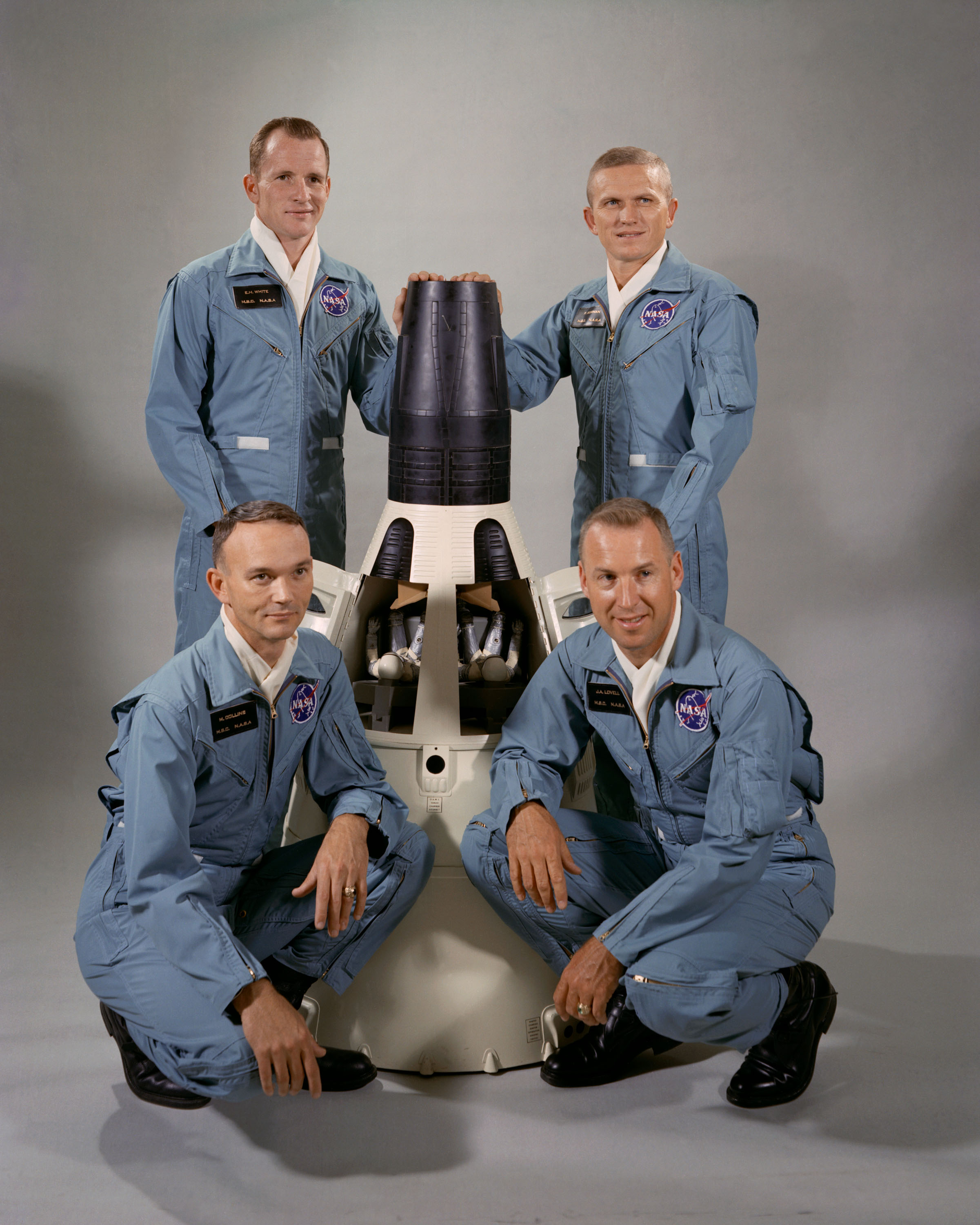
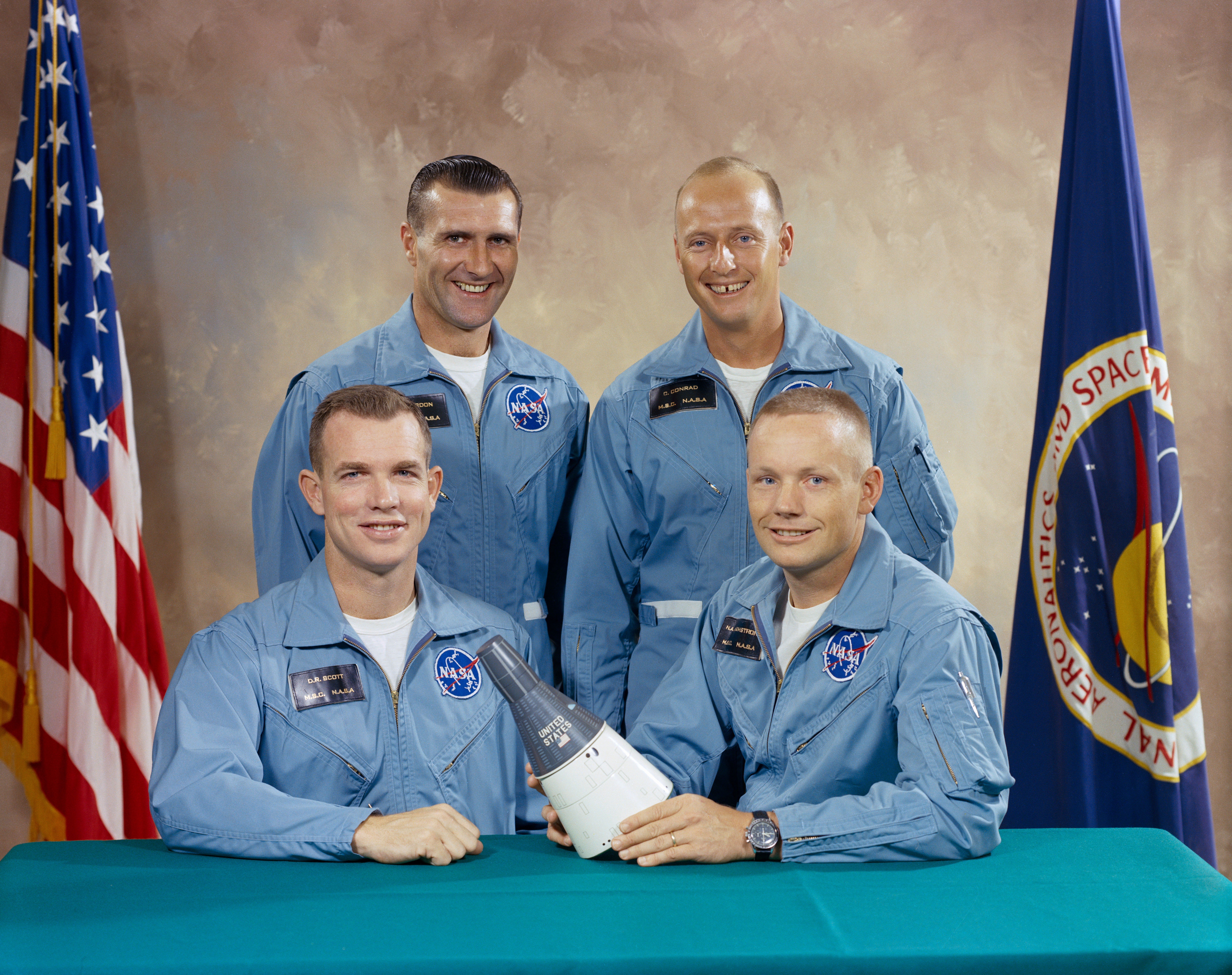
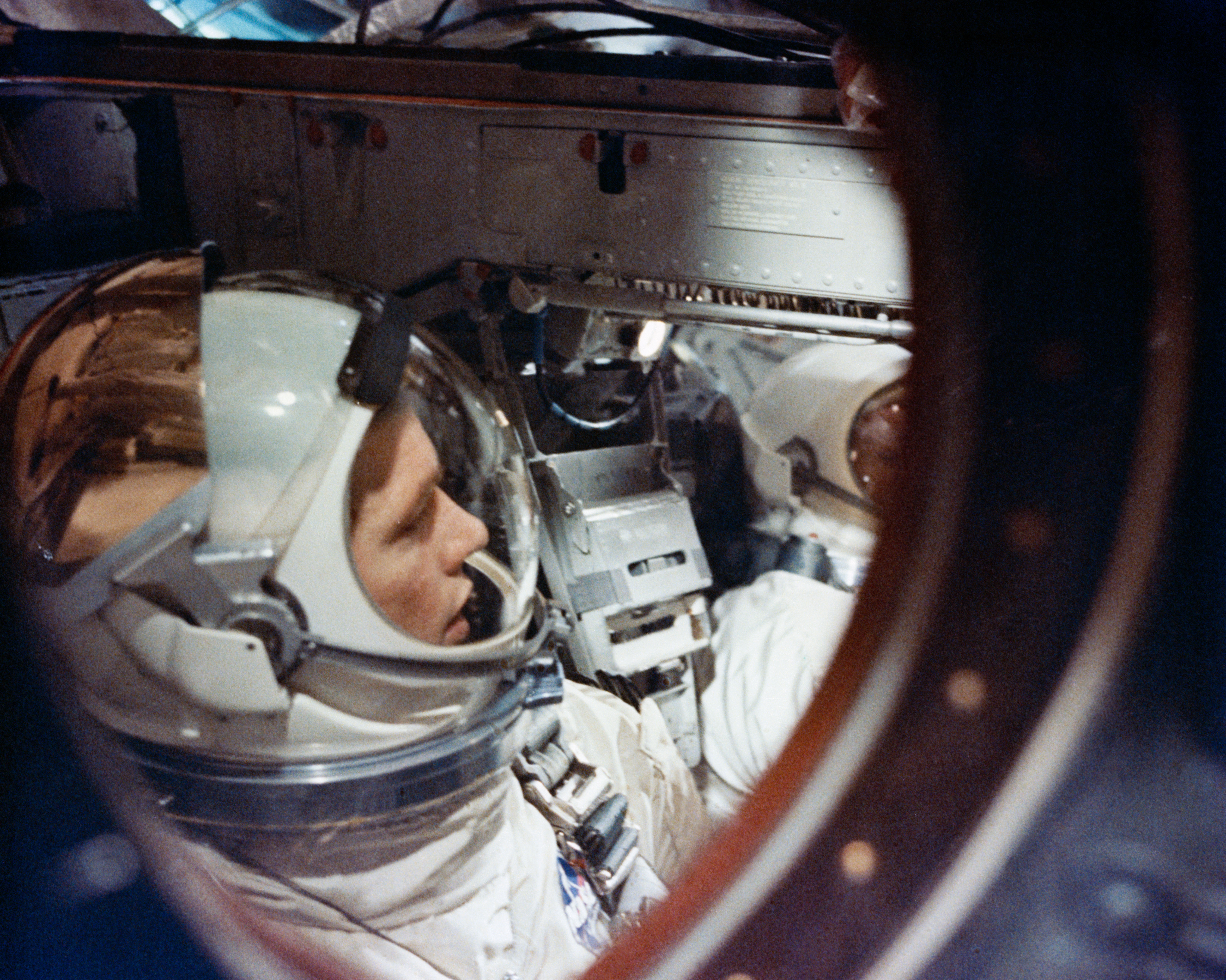
Left: Michael Collins, lower left, the first of The Fourteen to receive a crew assignment as backup pilot on Gemini VII. Middle: David R. Scott, lower left, received the first assignment to a prime crew as Gemini VIII pilot – fellow Fourteen Richard F. Gordon was assigned as his backup. Right: Scott awaits launch inside Gemini VIII.
Quelle: NASA

